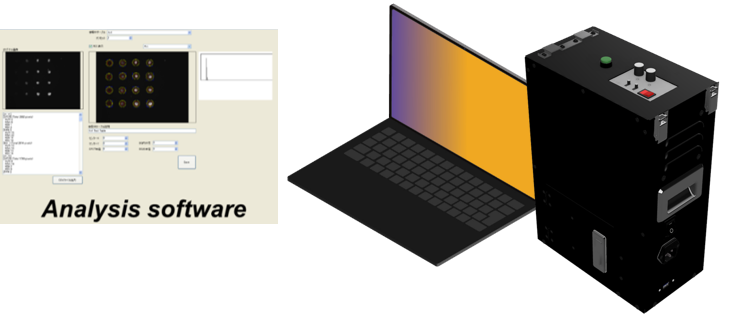PepTenChip® is a Biochip for the next generation used for characterization of proteins



PepTenChip®:Technical Notes and Product Information

PepTenChip® Chinese ver.( 中文版.)
Significance
①Biomolecular recognition is structures to structures
②Proteins can be mimicked by peptides.
③Peptides can be designed and synthesized.
④Peptides can make 3D-structures.
⑤The PepTenChip® system does not involve only detection of specific molecules (such as markers) in a 1:1 manner, but also unknown and surrogate markers responsible to diseases can be clarified.
⑥The detection principle is the differences in fluorescent intensity change of capture peptides caused by analytes.
⑦The structural change of the analyte-peptide interaction is reflected in the fluorescent-intensity changes of the capture molecules in a dose dependent manner (PAT: JP-US-EU).
⑧PepTenChip®, a sensor device, discriminates 3D-structures of proteins
⑨The novel chip material made from amorphous carbon has been developed, which has significant advantages over conventional glass slides (PAT & PAT.P).
⑩The PepTenChip® plates are suitable also for array consisting of DNA, sugar, antibody, antigen and low molecular compounds.
⑪The basic chemical modification of our surface is through a carboxyl group and further derivatization to amino group, bromoacetyl group, succinimide ester, maleimide or biotin-streptavidin is easily achieved.
⑫The protein can be identified through a data base by the protein fingerprint method (Informatics).

PepTenChip® System
•In conventional methods analytes should be labeled, although in the PepTenChip® System capture molecules are labeled. After application of samples washing is not necessary.
•Unlike proteins, peptides can be used after dried. One of advantages in industrial production and higher throughput, saving costs, easier delivery. Mol. BioSys., 2, 113, 2006
•Arrayed capture molecules of PepTenChip® are designed peptides, which had been synthesized, purified and characterized. Additionally recognition can be structurally optimized.
•Chip material: The novel material made from amorphous carbon has been developed for biochips, which has significant advantages over conventional glass slides as summarized in the next table. (PAT & PAT.P)


- No self-fluorescence
- Chemically inert
- Higher thermal & electric conductivity
- It can be used as a sample tray of MALDI-TOF-MS
- Environmentally friendly (regeneration is easy)
- Grinding Flatness (<10 micron)
- Extremely low back ground
- Lowest non-specific adsorption
- Mechanically stable (easy handling)
- Higher stability (storage/transport)
- Uniformed distribution of functional groups (higher reproducibility)
- Higher reproducibility + sensitivity for protein detection
- Many surface chemistry (derivatization with vaiety of functional groups
- Patented method for Quality control: determination of surface amino groups
Forte:
①DIN A4 size(ca 5 Liter)
②Easily carried (ca 5 Kg)
③Power supply allow to stand outside
④Lap-top PC connection with USB
⑤Field use (carry on baggage size)

Bio-molecular Recognition using Biochip→ Medical examination
Research tools, safety control for food, agricultural chemicals, environmental analyses, diagnosis, early detection and prevention of disease, home medical care, on-site examination
•Glycopeptide array showed a different response to the toxin protein. Depending on the type of sugar is different reactivity of the protein. This technology may contribute to the safety inspection of food.
•In world-wide no technologies similar to PepTenChip® are envisaged. Material and surface chemistry are unique.
•Products: chips, related equipment, contract based biodetection and arrays
•Related articles and technical data can be down loaded from HiPep website

